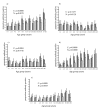Acquisition of naturally occurring antibody responses to recombinant protein domains of Plasmodium falciparum erythrocyte membrane protein 1
- PMID: 18706102
- PMCID: PMC2533674
- DOI: 10.1186/1475-2875-7-155
Acquisition of naturally occurring antibody responses to recombinant protein domains of Plasmodium falciparum erythrocyte membrane protein 1
Abstract
Background: Antibodies targeting variant antigens expressed on the surface of Plasmodium falciparum infected erythrocytes have been associated with protection from clinical malaria. The precise target for these antibodies is unknown. The best characterized and most likely target is the erythrocyte surface-expressed variant protein family Plasmodium falciparum erythrocyte membrane protein 1 (PfEMP1).
Methods: Using recombinant proteins corresponding to five domains of the expressed A4 var gene, A4 PfEMP1, the naturally occurring antibody response was assessed, by ELISA, to each domain in serum samples obtained from individuals resident in two communities of differing malaria transmission intensity on the Kenyan coast. Using flow cytometry, the correlation in individual responses to each domain with responses to intact A4-infected erythrocytes expressing A4 PfEMP1 on their surface as well as responses to two alternative parasite clones and one clinical isolate was assessed.
Results: Marked variability in the prevalence of responses between each domain and between each transmission area was observed, as wasa strong correlation between age and reactivity with some but not all domains. Individual responses to each domain varied strikingly, with some individuals showing reactivity to all domains and others with no reactivity to any, this was apparent at all age groups. Evidence for possible cross-reactivity in responses to the domain DBL4gamma was found.
Conclusion: Individuals acquire antibodies to surface expressed domains of a highly variant protein. The finding of potential cross-reactivity in responses to one of these domains is an important initial finding in the consideration of potential vaccine targets.
Figures



Similar articles
-
Hierarchical, domain type-specific acquisition of antibodies to Plasmodium falciparum erythrocyte membrane protein 1 in Tanzanian children.Infect Immun. 2010 Nov;78(11):4653-9. doi: 10.1128/IAI.00593-10. Epub 2010 Sep 7. Infect Immun. 2010. PMID: 20823214 Free PMC article.
-
The humoral response to Plasmodium falciparum VarO rosetting variant and its association with protection against malaria in Beninese children.Malar J. 2010 Oct 5;9:267. doi: 10.1186/1475-2875-9-267. Malar J. 2010. PMID: 20923548 Free PMC article.
-
Immunogenicity of the Plasmodium falciparum PfEMP1-VarO Adhesin: Induction of Surface-Reactive and Rosette-Disrupting Antibodies to VarO Infected Erythrocytes.PLoS One. 2015 Jul 29;10(7):e0134292. doi: 10.1371/journal.pone.0134292. eCollection 2015. PLoS One. 2015. PMID: 26222304 Free PMC article.
-
Analysis of antibody induction upon immunization with distinct NTS-DBL1α-domains of PfEMP1 from rosetting Plasmodium falciparum parasites.Malar J. 2013 Jan 24;12:32. doi: 10.1186/1475-2875-12-32. Malar J. 2013. PMID: 23347690 Free PMC article.
-
The role of antibodies to Plasmodium falciparum-infected-erythrocyte surface antigens in naturally acquired immunity to malaria.Trends Microbiol. 2002 Feb;10(2):55-8. doi: 10.1016/s0966-842x(01)02278-8. Trends Microbiol. 2002. PMID: 11827798 Review.
Cited by
-
The kinetics of antibody binding to Plasmodium falciparum VAR2CSA PfEMP1 antigen and modelling of PfEMP1 antigen packing on the membrane knobs.Malar J. 2010 Apr 19;9:100. doi: 10.1186/1475-2875-9-100. Malar J. 2010. PMID: 20403153 Free PMC article.
-
Allelic diversity of the Plasmodium falciparum erythrocyte membrane protein 1 entails variant-specific red cell surface epitopes.PLoS One. 2011 Jan 27;6(1):e16544. doi: 10.1371/journal.pone.0016544. PLoS One. 2011. PMID: 21298021 Free PMC article.
-
Specific antibody responses against membrane proteins of erythrocytes infected by Plasmodium falciparum of individuals briefly exposed to malaria.Malar J. 2010 Oct 11;9:276. doi: 10.1186/1475-2875-9-276. Malar J. 2010. PMID: 20932351 Free PMC article.
-
How selection forces dictate the variant surface antigens used by malaria parasites.J R Soc Interface. 2012 Feb 7;9(67):246-60. doi: 10.1098/rsif.2011.0239. Epub 2011 Jul 6. J R Soc Interface. 2012. PMID: 21733875 Free PMC article.
-
Opsonic phagocytosis of Plasmodium falciparum merozoites: mechanism in human immunity and a correlate of protection against malaria.BMC Med. 2014 Jul 1;12:108. doi: 10.1186/1741-7015-12-108. BMC Med. 2014. PMID: 24980799 Free PMC article.
References
-
- Edozien JC, Gilles HM, Udeozo IOK. Adult and cord-blood immunoglobulin immunity to malaria in Nigerians. Lancet. 1962;2:951–955. doi: 10.1016/S0140-6736(62)90725-0. - DOI
-
- Esposito F, Lombardi S, Modiano D, Zavala F, Reeme J, Lamizana L, Coluzzi M, Nussenzweig RS. Prevalence and levels of antibodies to the circumsporozoite protein of Plasmodium falciparum in an endemic area and their relationship to resistance against malaria infection. Trans R Soc Trop Med Hyg. 1988;82:827–832. doi: 10.1016/0035-9203(88)90007-7. - DOI - PubMed
-
- Calle JM, Nardin EH, Clavijo P, Boudin C, Stuber D, Takacs B, Nussenzweig RS, Cochrane AH. Recognition of different domains of the Plasmodium falciparum CS protein by the sera of naturally infected individuals compared with those of sporozoite-immunized volunteers. J Immunol. 1992;149:2695–2701. - PubMed
Publication types
MeSH terms
Substances
Grants and funding
LinkOut - more resources
Full Text Sources
Other Literature Sources
Research Materials

